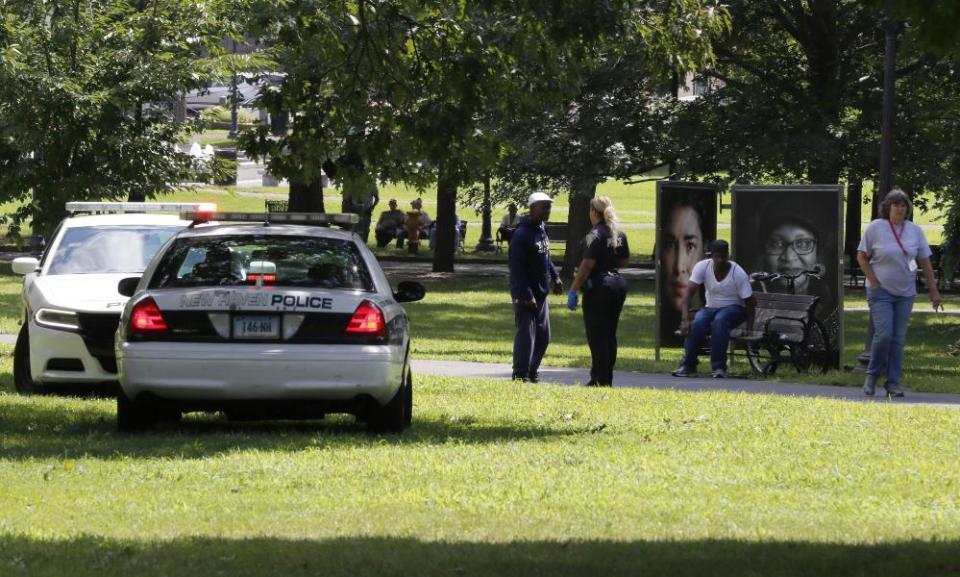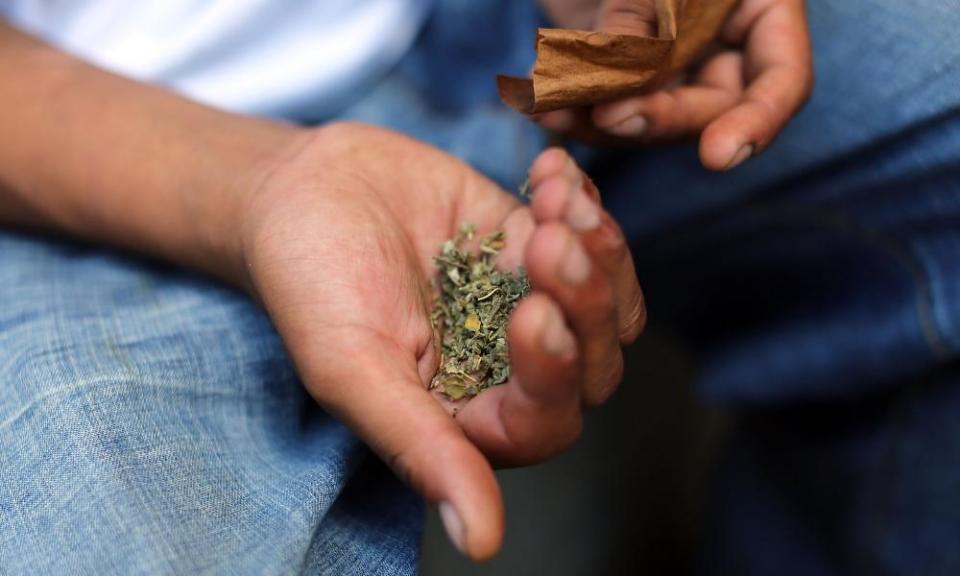'It's not just New Haven': mass K2 overdose symptom of national crisis

When a raised voice breaks out above the downtown din in New Haven Green park, the shouts are often drawing attention to yet another person who has had a bad reaction to the synthetic cannabinoid K2, also known as spice.
The drug users who frequent the 16-acre park in New Haven, Connecticut, which is just steps away from Yale University’s gothic campus, describe that reaction as a “fallout”, and so far it has happened to 95 people over the course of two days this week.
This mass, rapid-fire overdose event was a sped-up version of what is happening across the US as local and federal governments struggle to reduce the colliding impacts of opioid, methamphetamine, cocaine and other addictions.
Phil Costello, the clinical director for homeless care at Cornell Scott-Hill health center, works often in the Green from his temporary office under a tent. “That batch that came in yesterday, with all the people falling out, has just made this basically a mass casualty incident,” Costello said.
He and a team of other nurses and addiction counselors stood by cots, ready with bottled water and the overdose reversal agent narcan, which has proved largely ineffective against synthetic cannabinoids.
“I think it’s frustrating because for the team, because we don’t really have narcan that can fix it [the K2 overdoses],” Costello said. “It’s the addiction.”
In 2017, drug overdoses killed nearly 200 people per day, according to Centers for Disease Control and Prevention (CDC) data released this week, a new record driven by the deadly opioid epidemic.
Since K2 was first detected in the US in 2008, clusters of overdose outbreaks have become more and more common. About 56 people overdosed from K2 in Brooklyn in May; 100 people overdosed in Lancaster county, Pennsylvania, in July 2017 and 40 people overdosed in Dallas, Texas, in May 2014.
Sometimes K2 is laced with the powerful opioid fentanyl, but investigators including the federal Drug Enforcement Agency (DEA) said they have not yet found any in the New Haven sample.
Officials said there have not been any deaths from this batch of K2, but they fear the long-term consequences of a drug that causes hallucinations, vomiting and a rapid heart rate.
K2 is also known as synthetic marijuana because it interacts with cannabinoid receptors in the central nervous system to produce psychoactive effects. But K2 is much more potent and is an unpredictable mix of differing concentrations of different chemicals that are poured or sprayed on plant material.
Despite the mystery of each batch, K2 is appealing to drug users because its cost is low, its chemicals aren’t detected on standard drug tests and its changing mixtures make law enforcement efforts more complicated than with purer drugs such as marijuana.

“It’s just a daunting, daunting thought for the future,” said Costello. “This is a much bigger problem and a much bigger threat to national security than other things.”
Costello, a nurse, is known as “Dr Phil” to the hundreds of homeless who frequent the green and when not treating patients this week, he was constantly greeted by people he has helped in the past. “Everybody knows each other and they try to take care of each other the best they can,” Costello said.
The green has a manicured lawn and is surrounded by nice restaurants and cute shops, but it is also where people shoot drugs in the daytime and don’t hesitate to ask the stranger sharing a bench with them where to buy K2. It’s where hundreds of the city’s homeless spend their days, but the rest of the community doesn’t seem to linger.
Costello said on a normal day on the green, one or two people might need emergency medical care because of drug use. But not so with this batch, which police suspect was distributed by two men, including one accused of handing out it for nothing to lure in clients.
“With this particular version they have convulsions, psychotic episodes and become completely catatonic and barely responsive, which makes them very vulnerable to people who might want to take advantage of them,” Costello said.
At the peak of overdoses on Wednesday, 46 ambulances were responding to calls.
“People were dropping all over the green, it was just mass amounts of people,” said Daena Murphy, a clinical social worker at the community health center, Cornell Scott Hill Health Corporation, who worked alongside Costello this week.
“Fallout” rates slowed on Thursday, though in one 15-minute period, police and health workers darted around the park to respond to three distressed individuals.
A bystander or friend would call out, wave their arms and point at a victim lying on the ground or silent and still on a bench. In seconds, someone with a stethoscope, stretcher or water bottle would be running their way and ambulances would surround the scene.
Murphy warned that what had happened this week in this city of 129,934 people was happening across the US.
“After the TV cameras leave, we are still here,” Murphy said. “It’s not just New Haven.”
The dean of the Yale school of public health, Sten Vermund, said: “My fear is that the synthetic cannabinoids might be a new wave.”
“It’s occupying the fire department, the emergency room at Yale, you can imagine the pain and suffering of the patients’ families, on the patients themselves,” Vermund said. “It’s quite a big burden on a small city. It would be a big burden on a big city.”
Yale has been on the frontline of responding to the New Haven city green overdoses, with its emergency room caring for most of those affected and its pharmacologists analyzing the product and blood tests.
Vermund said: “This [K2] is a bit of a drug du jour but it’s in the context of a fairly substantial substance abuse crisis we have in the US.”

 Yahoo News
Yahoo News 